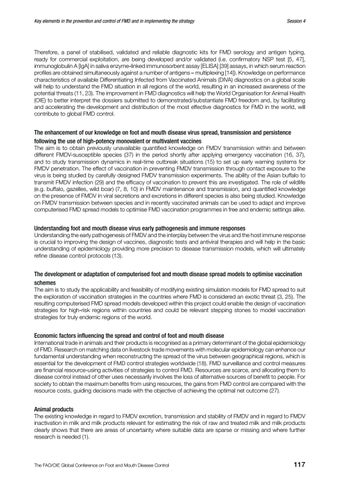Key elements in the prevention and control of FMD and in implementing the strategy
Session 4
Therefore, a panel of stabilised, validated and reliable diagnostic kits for FMD serology and antigen typing, ready for commercial exploitation, are being developed and/or validated (i.e. confirmatory NSP test [5, 47], immunoglobulin A [IgA] in saliva enzyme-linked immunosorbent assay [ELISA] [39] assays, in which serum reaction profiles are obtained simultaneously against a number of antigens – multiplexing [14]). Knowledge on performance characteristics of available Differentiating Infected from Vaccinated Animals (DIVA) diagnostics on a global scale will help to understand the FMD situation in all regions of the world, resulting in an increased awareness of the potential threats (11, 23). The improvement in FMD diagnostics will help the World Organisation for Animal Health (OIE) to better interpret the dossiers submitted to demonstrated/substantiate FMD freedom and, by facilitating and accelerating the development and distribution of the most effective diagnostics for FMD in the world, will contribute to global FMD control.
The enhancement of our knowledge on foot and mouth disease virus spread, transmission and persistence following the use of high-potency monovalent or multivalent vaccines The aim is to obtain previously unavailable quantified knowledge on FMDV transmission within and between different FMDV-susceptible species (37) in the period shortly after applying emergency vaccination (16, 37), and to study transmission dynamics in real-time outbreak situations (15) to set up early warning systems for FMDV penetration. The effect of vaccination in preventing FMDV transmission through contact exposure to the virus is being studied by carefully designed FMDV transmission experiments. The ability of the Asian buffalo to transmit FMDV infection (29) and the efficacy of vaccination to prevent this are investigated. The role of wildlife (e.g. buffalo, gazelles, wild boar) (7, 8, 10) in FMDV maintenance and transmission, and quantified knowledge on the presence of FMDV in viral secretions and excretions in different species is also being studied. Knowledge on FMDV transmission between species and in recently vaccinated animals can be used to adapt and improve computerised FMD spread models to optimise FMD vaccination programmes in free and endemic settings alike.
Understanding foot and mouth disease virus early pathogenesis and immune responses Understanding the early pathogenesis of FMDV and the interplay between the virus and the host immune response is crucial to improving the design of vaccines, diagnostic tests and antiviral therapies and will help in the basic understanding of epidemiology providing more precision to disease transmission models, which will ultimately refine disease control protocols (13).
The development or adaptation of computerised foot and mouth disease spread models to optimise vaccination schemes The aim is to study the applicability and feasibility of modifying existing simulation models for FMD spread to suit the exploration of vaccination strategies in the countries where FMD is considered an exotic threat (3, 25). The resulting computerised FMD spread models developed within this project could enable the design of vaccination strategies for high-risk regions within countries and could be relevant stepping stones to model vaccination strategies for truly endemic regions of the world.
Economic factors influencing the spread and control of foot and mouth disease International trade in animals and their products is recognised as a primary determinant of the global epidemiology of FMD. Research on matching data on livestock trade movements with molecular epidemiology can enhance our fundamental understanding when reconstructing the spread of the virus between geographical regions, which is essential for the development of FMD control strategies worldwide (18). FMD surveillance and control measures are financial resource-using activities of strategies to control FMD. Resources are scarce, and allocating them to disease control instead of other uses necessarily involves the loss of alternative sources of benefit to people. For society to obtain the maximum benefits from using resources, the gains from FMD control are compared with the resource costs, guiding decisions made with the objective of achieving the optimal net outcome (27).
Animal products The existing knowledge in regard to FMDV excretion, transmission and stability of FMDV and in regard to FMDV inactivation in milk and milk products relevant for estimating the risk of raw and treated milk and milk products clearly shows that there are areas of uncertainty where suitable data are sparse or missing and where further research is needed (1).
The FAO/OIE Global Conference on Foot and Mouth Disease Control
117
















